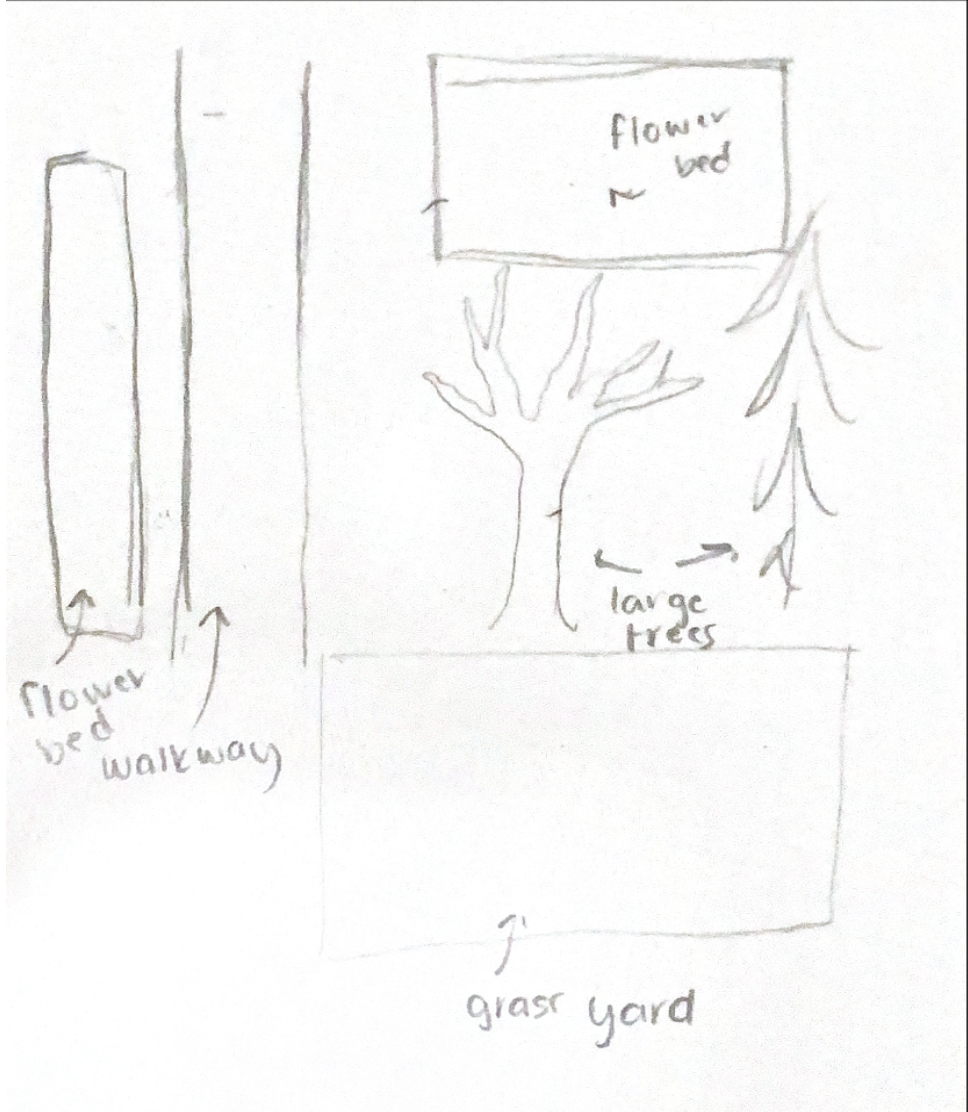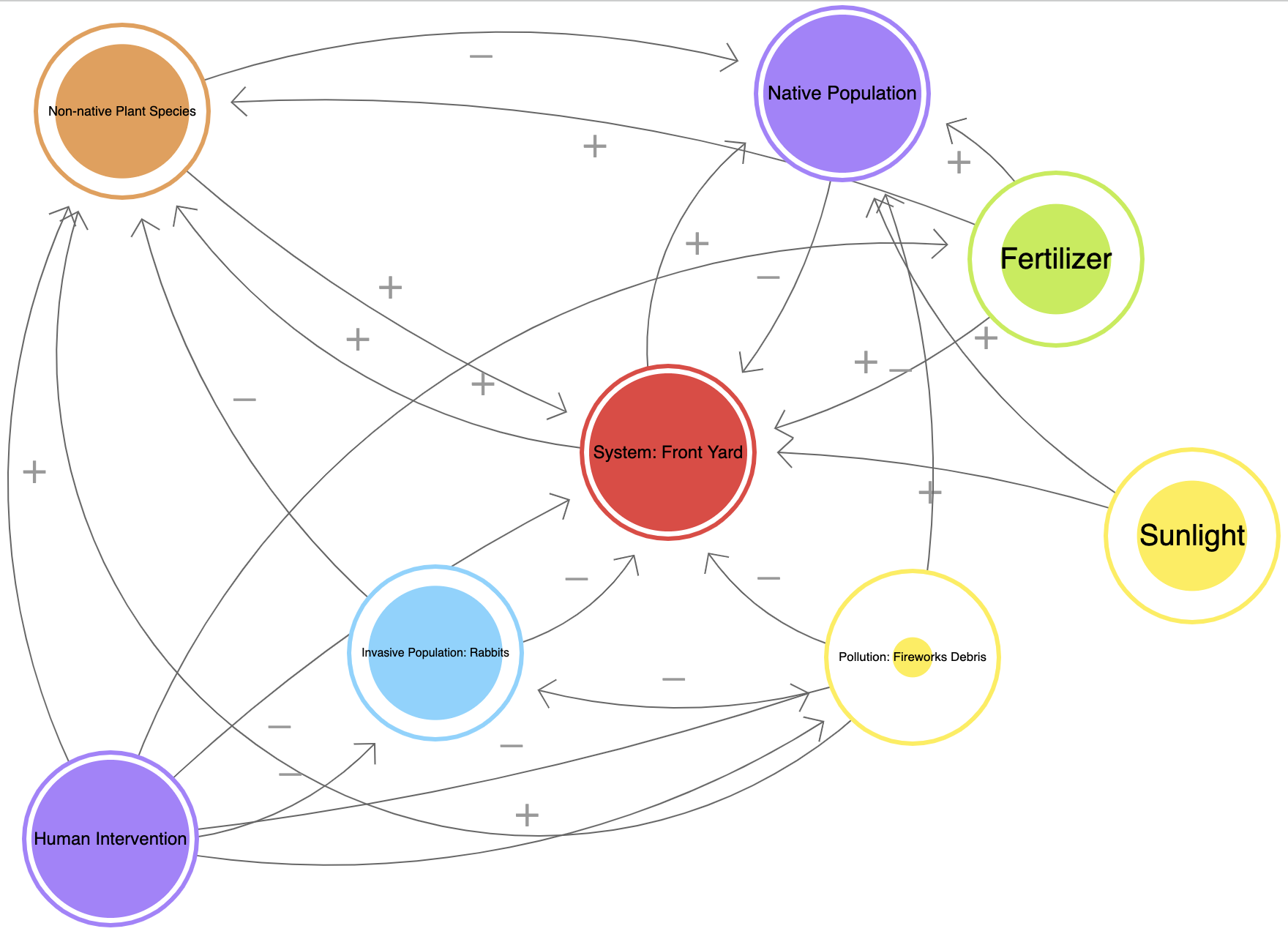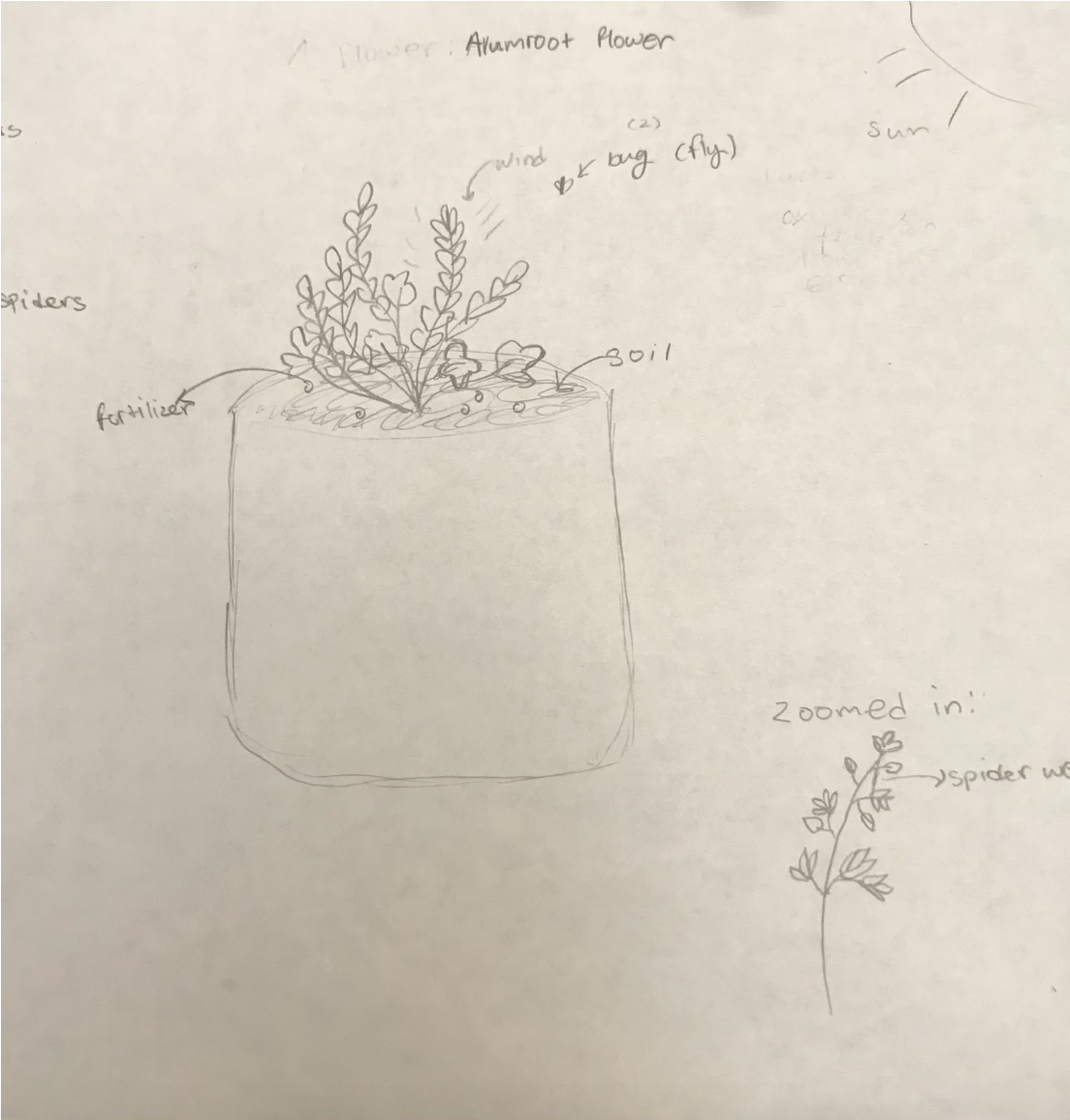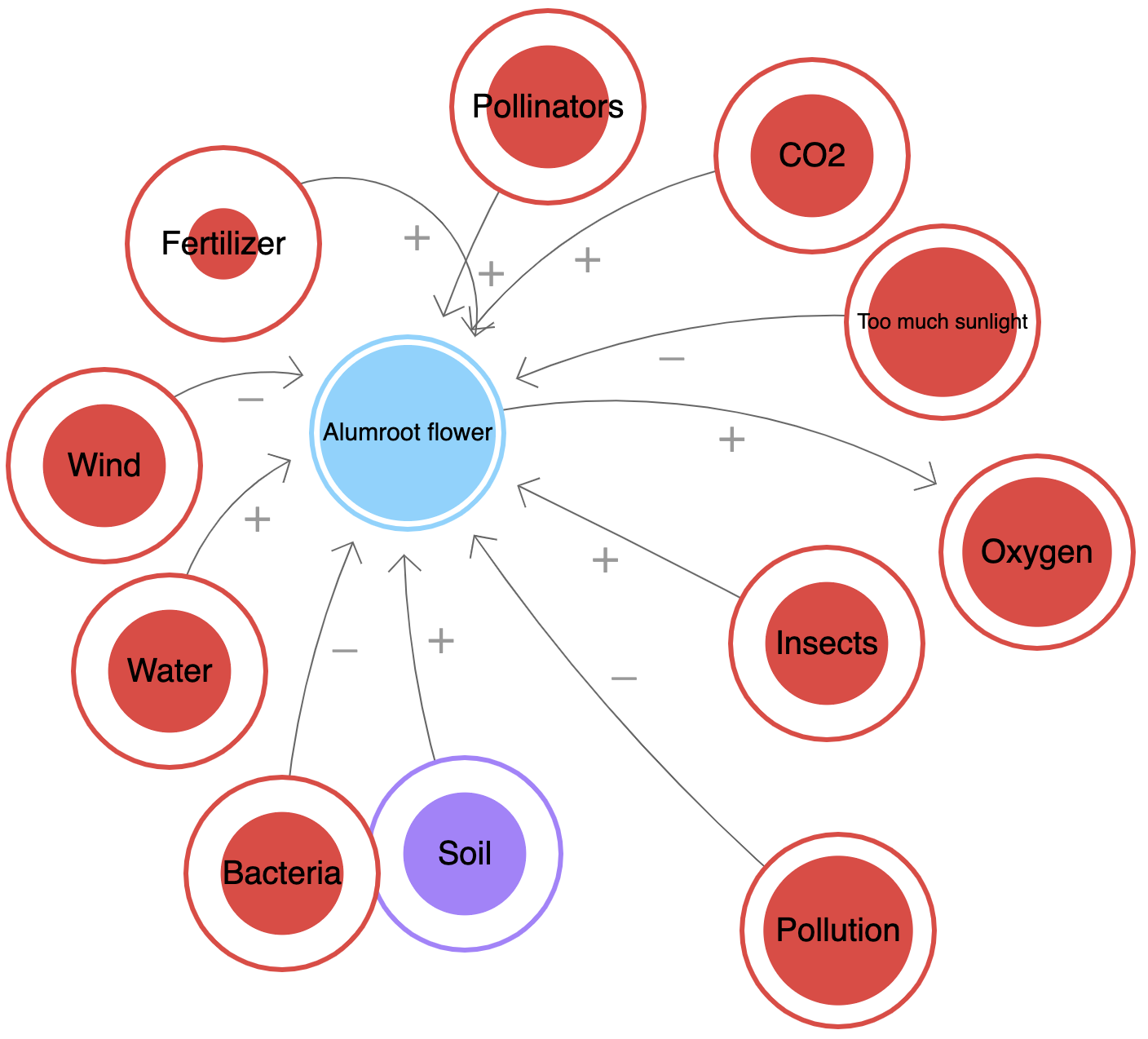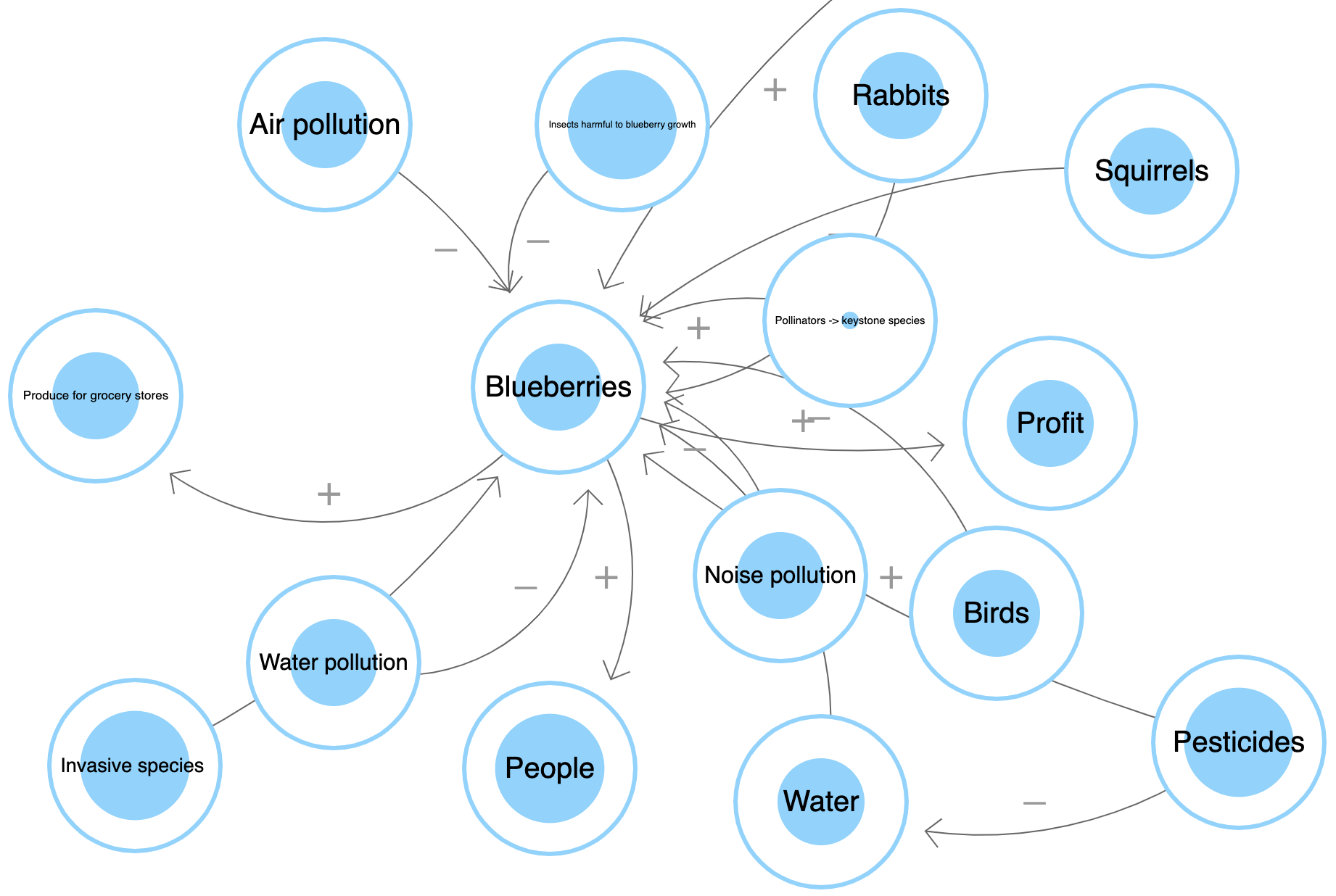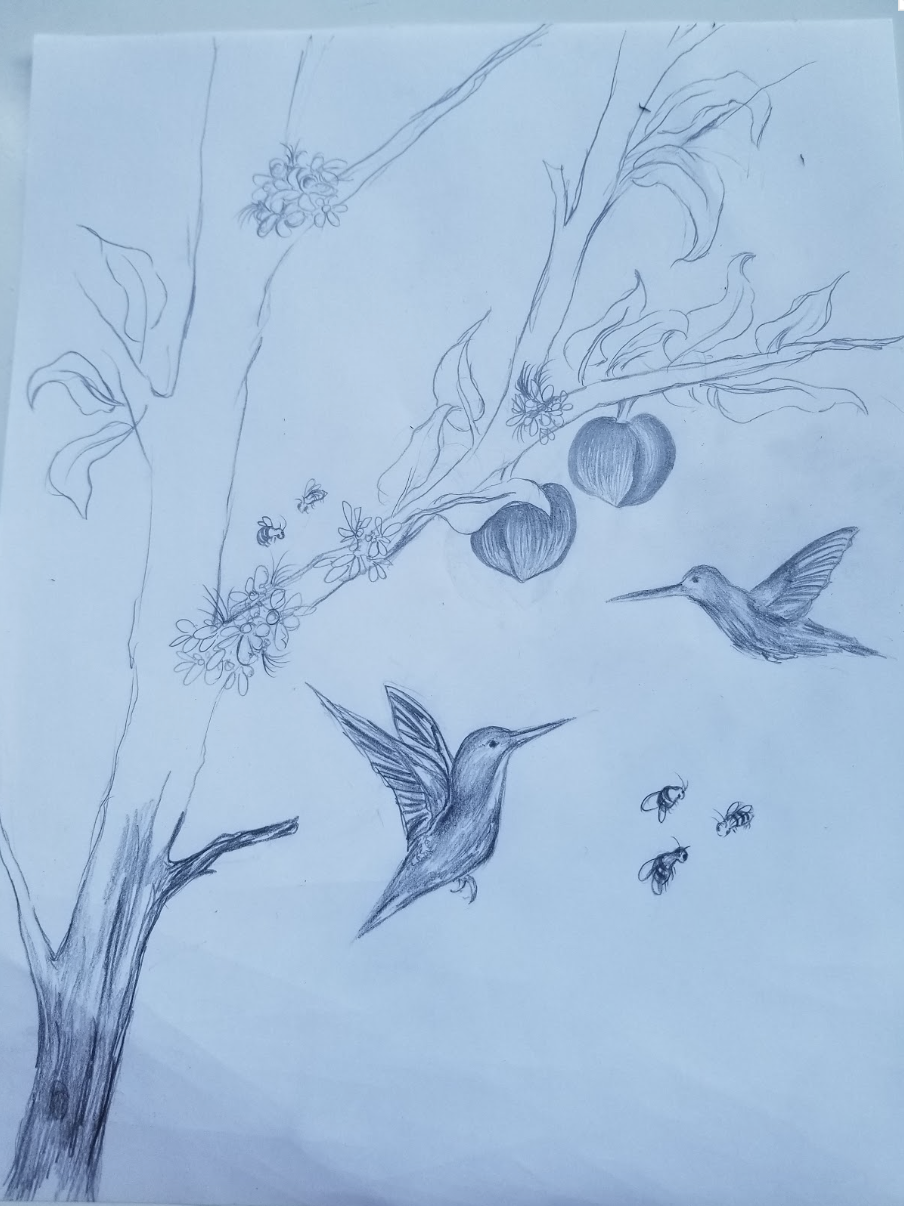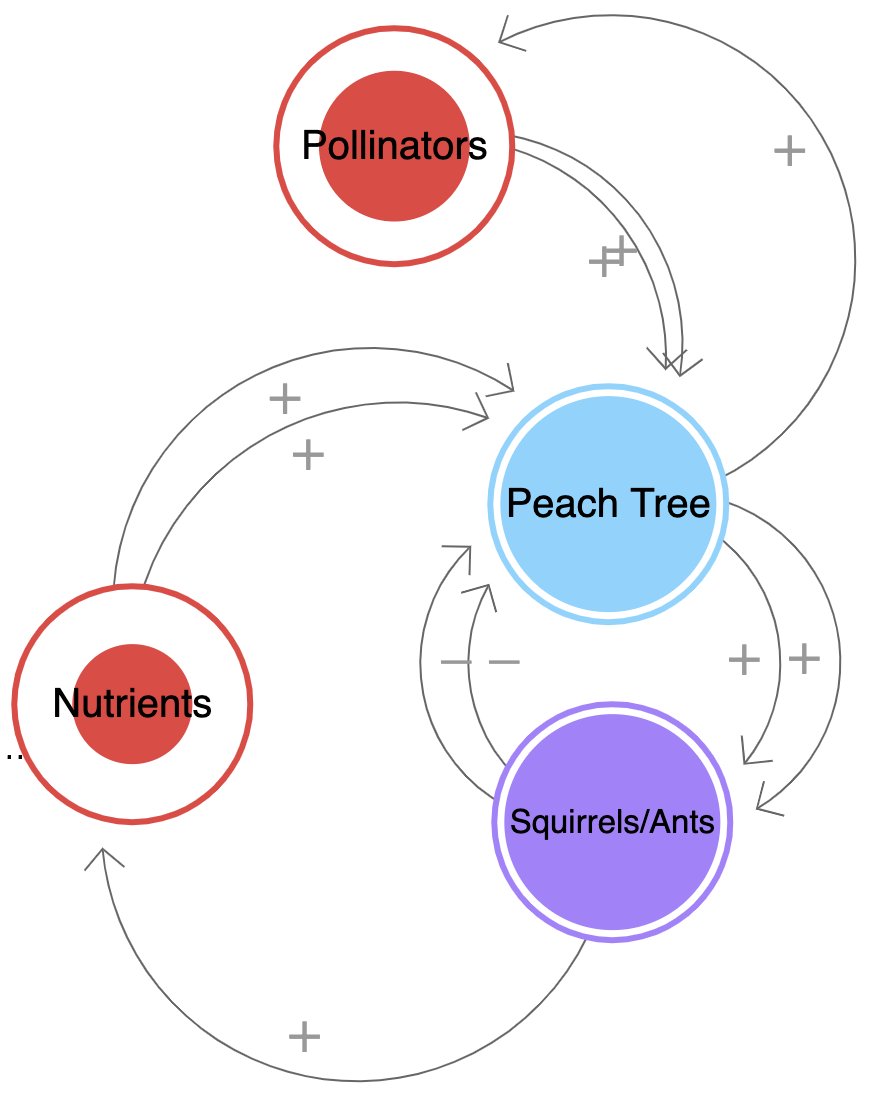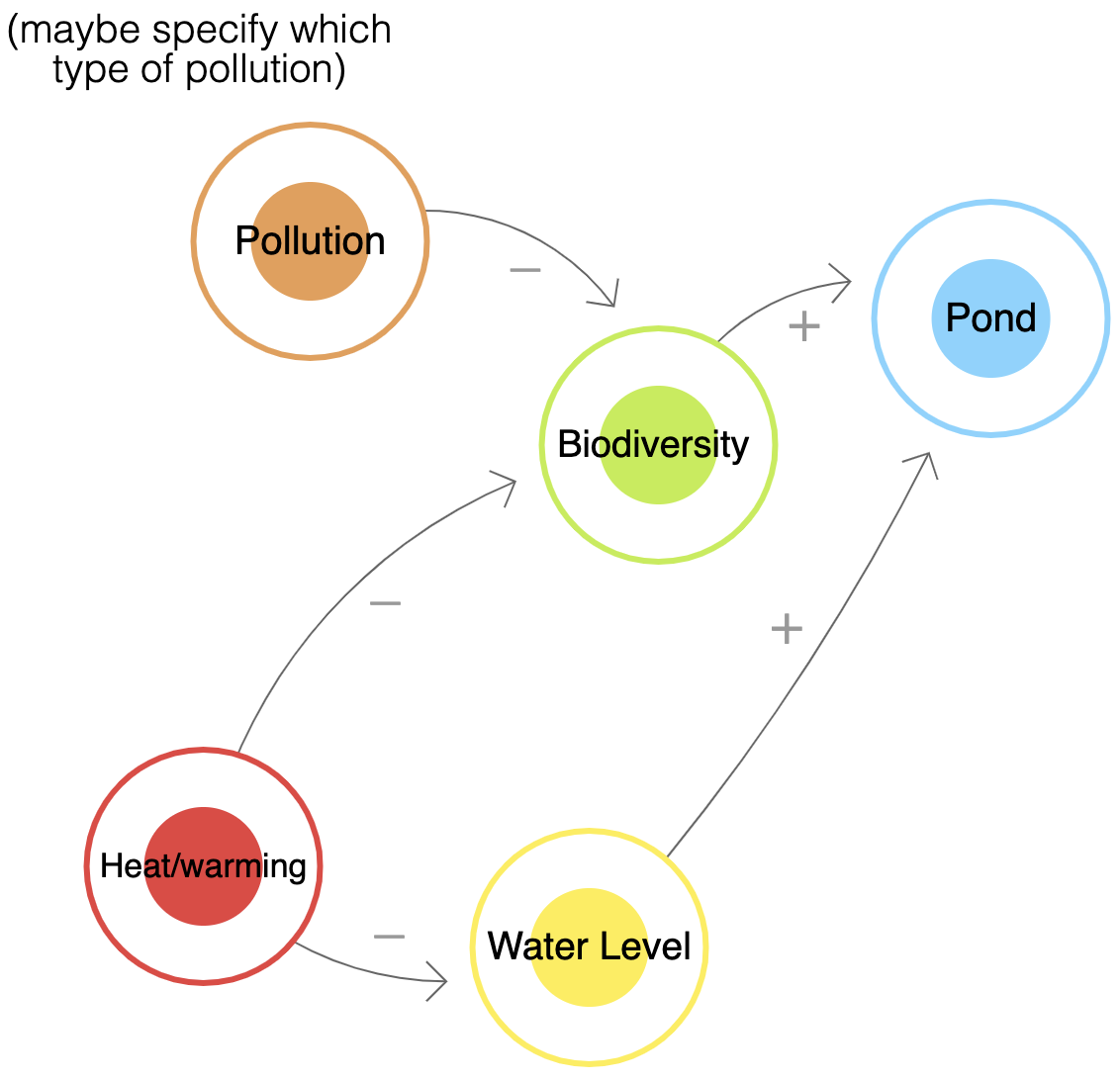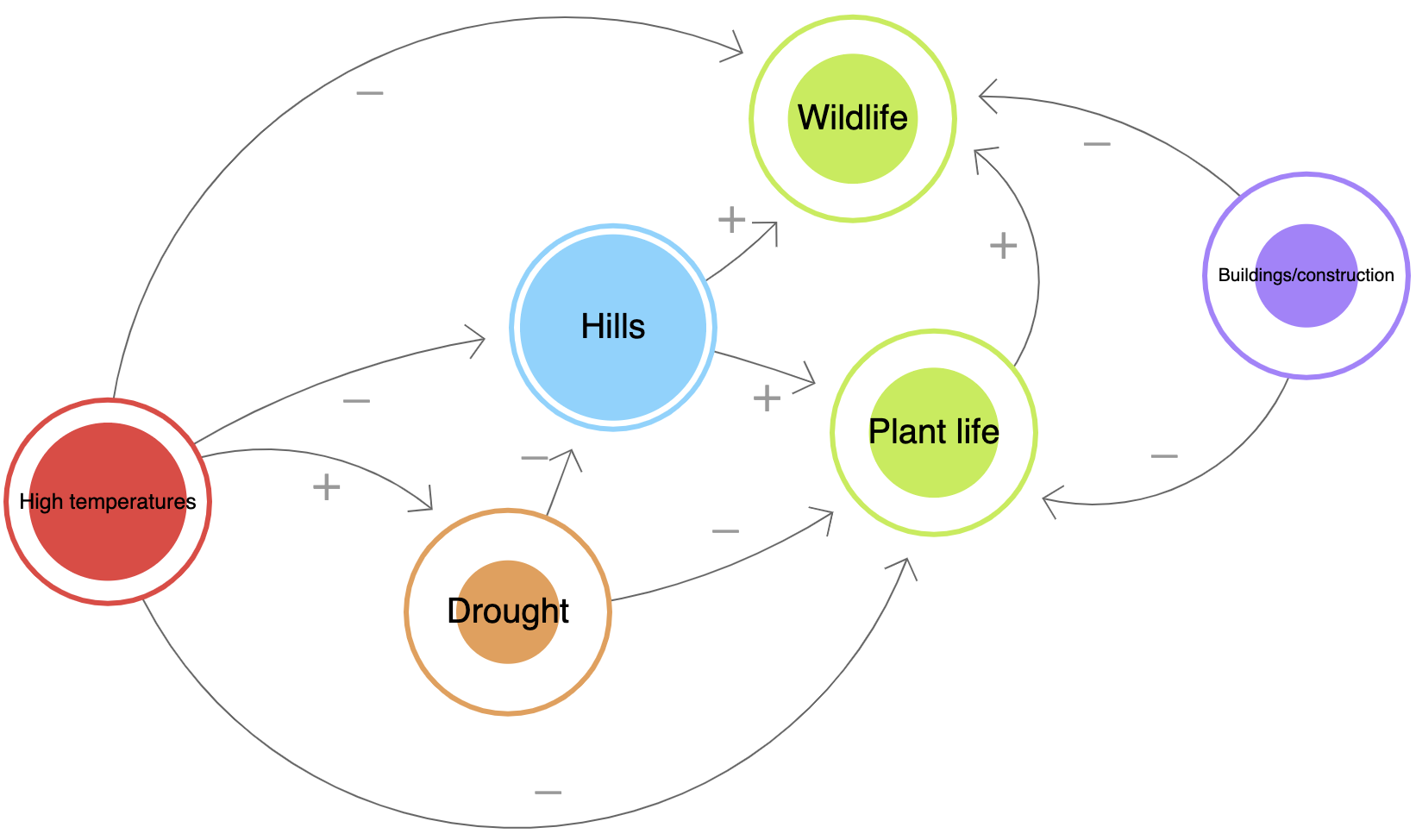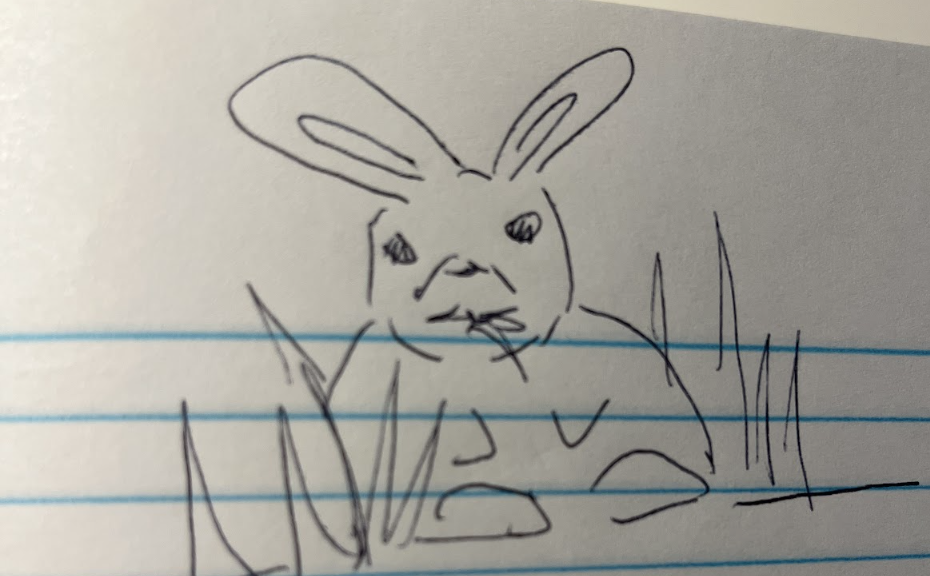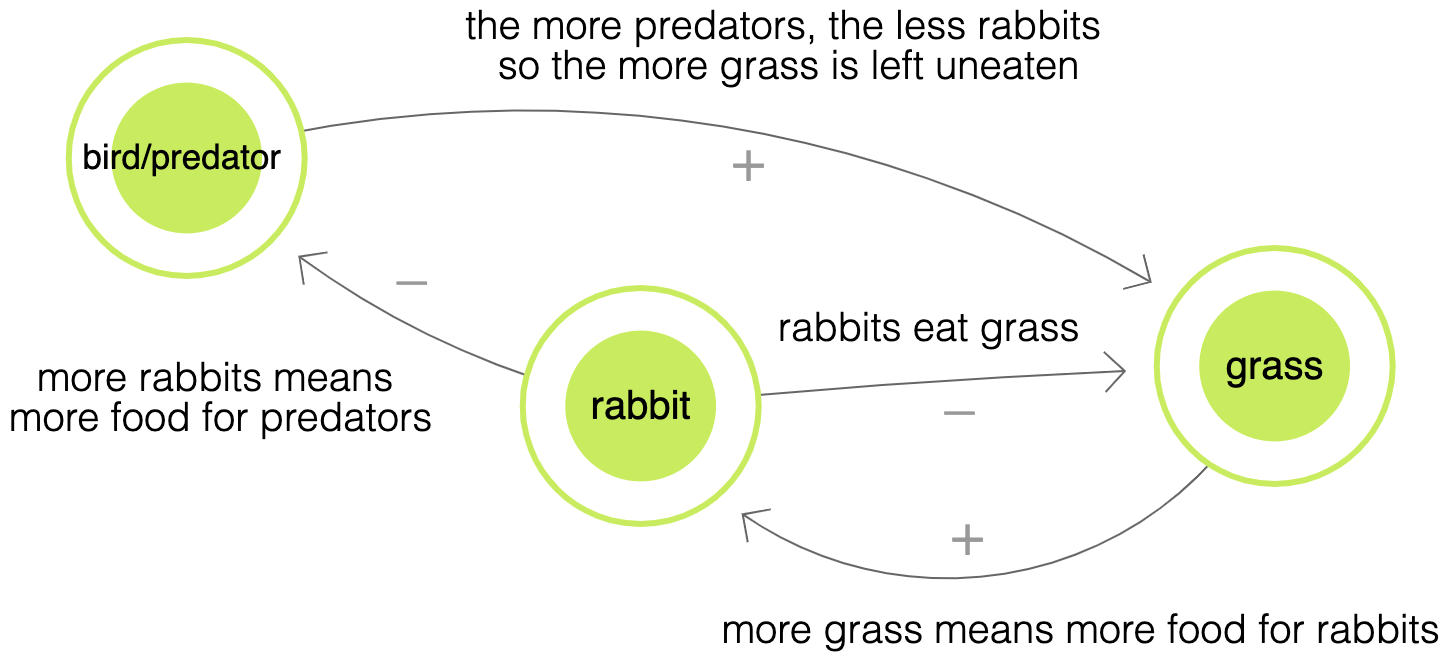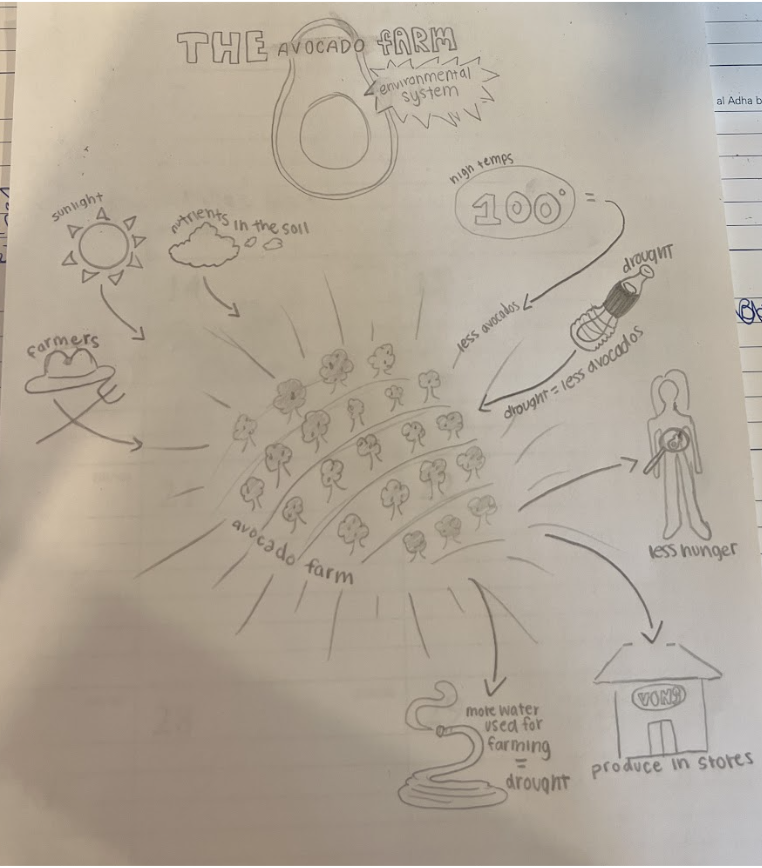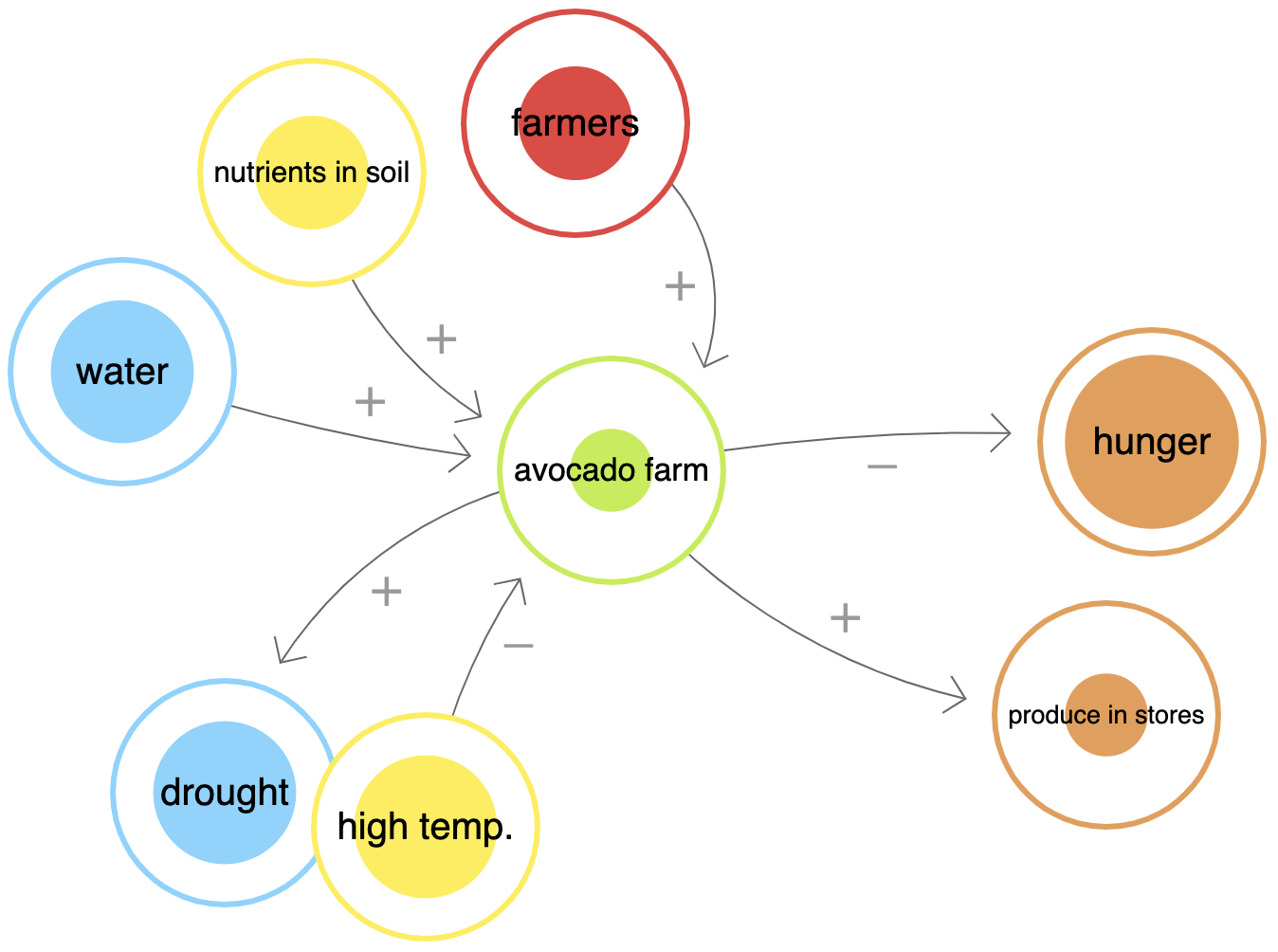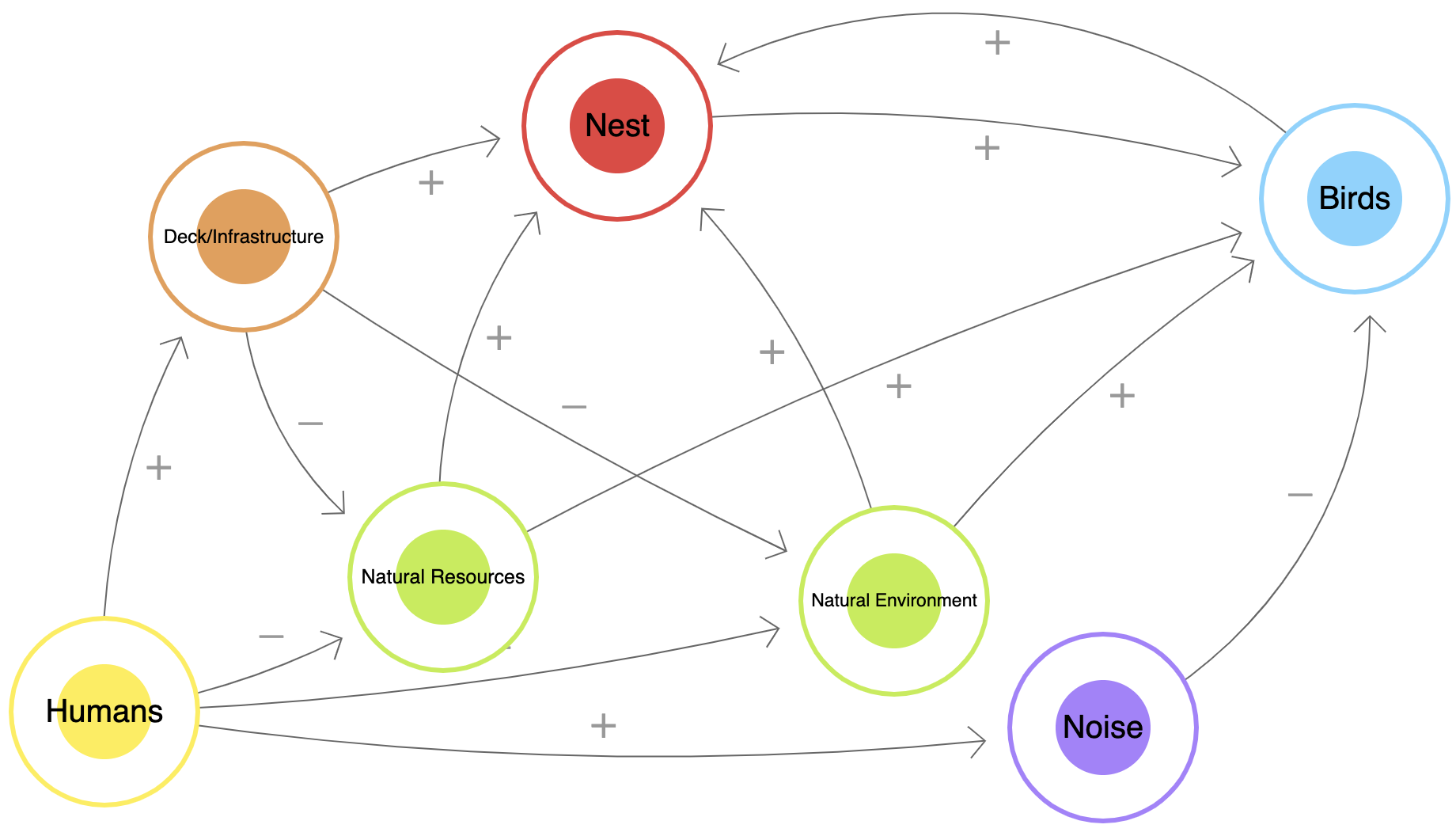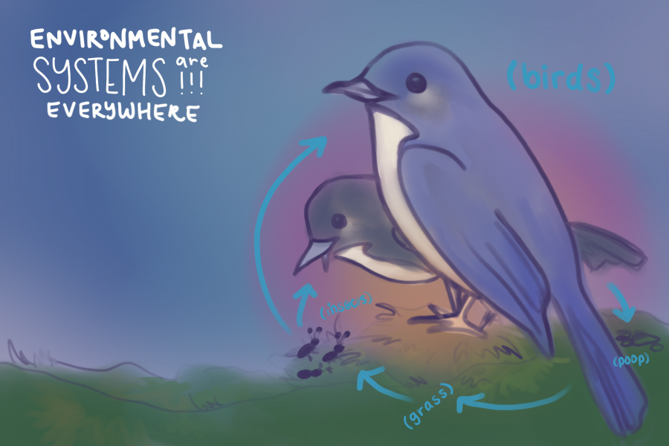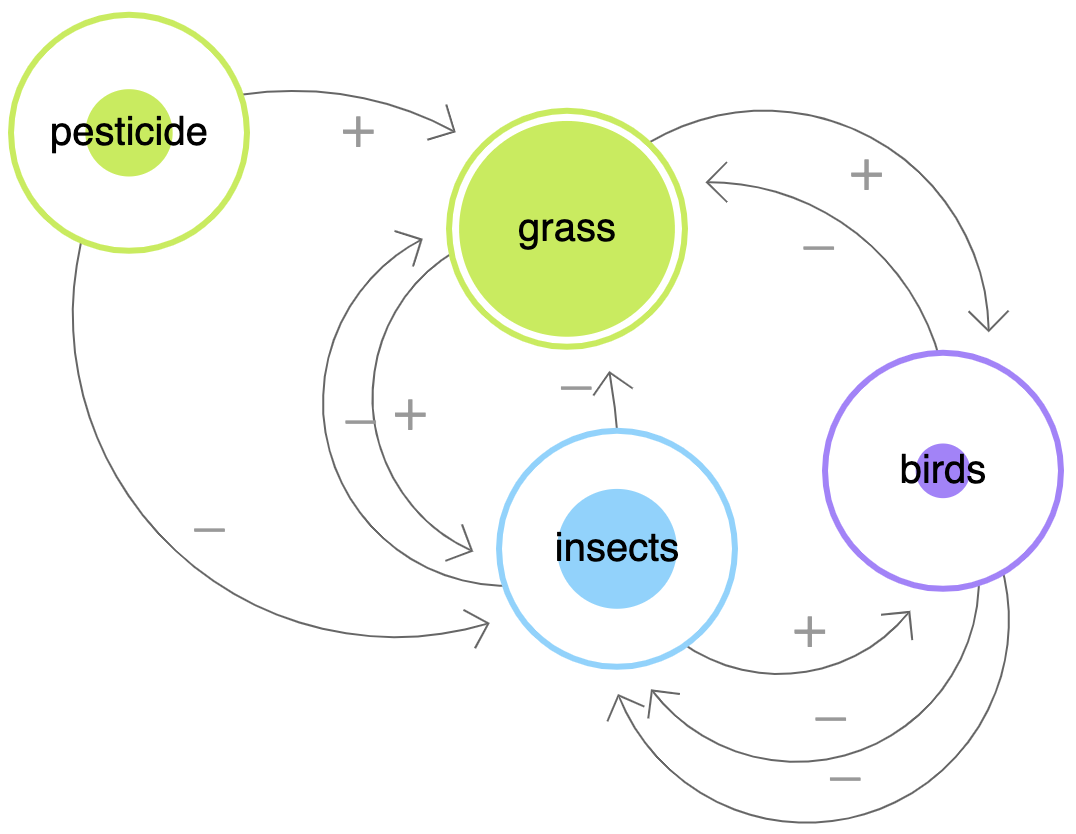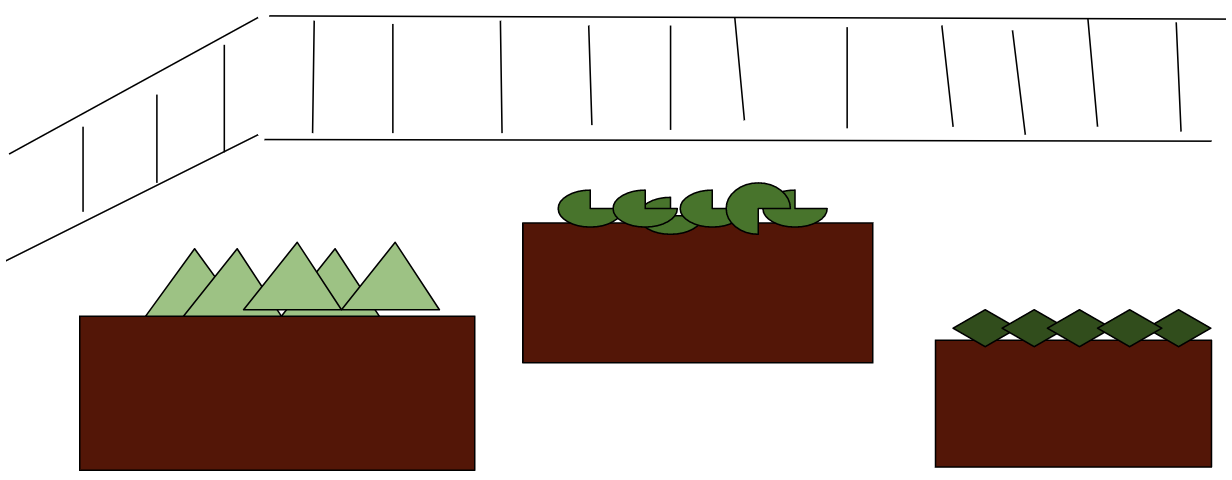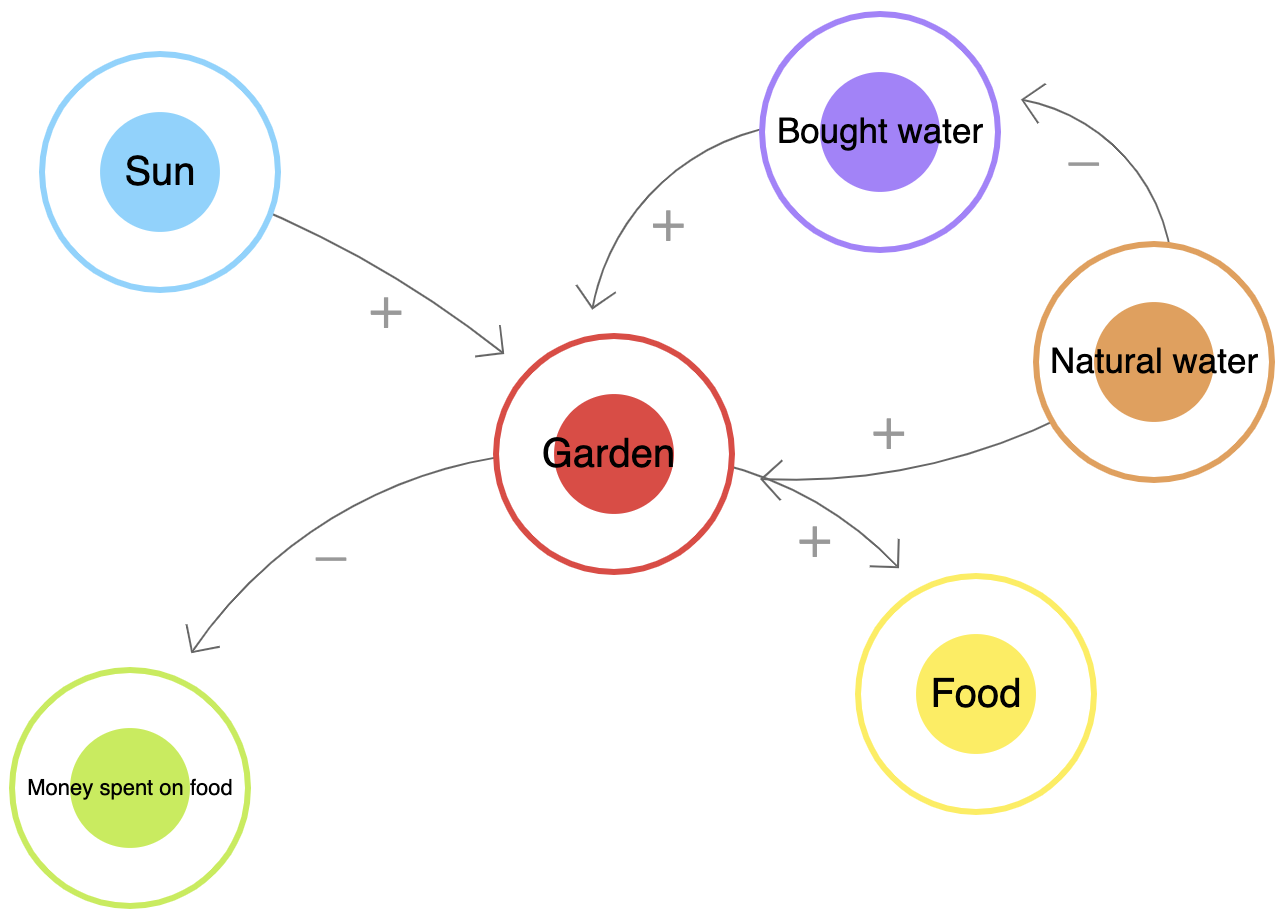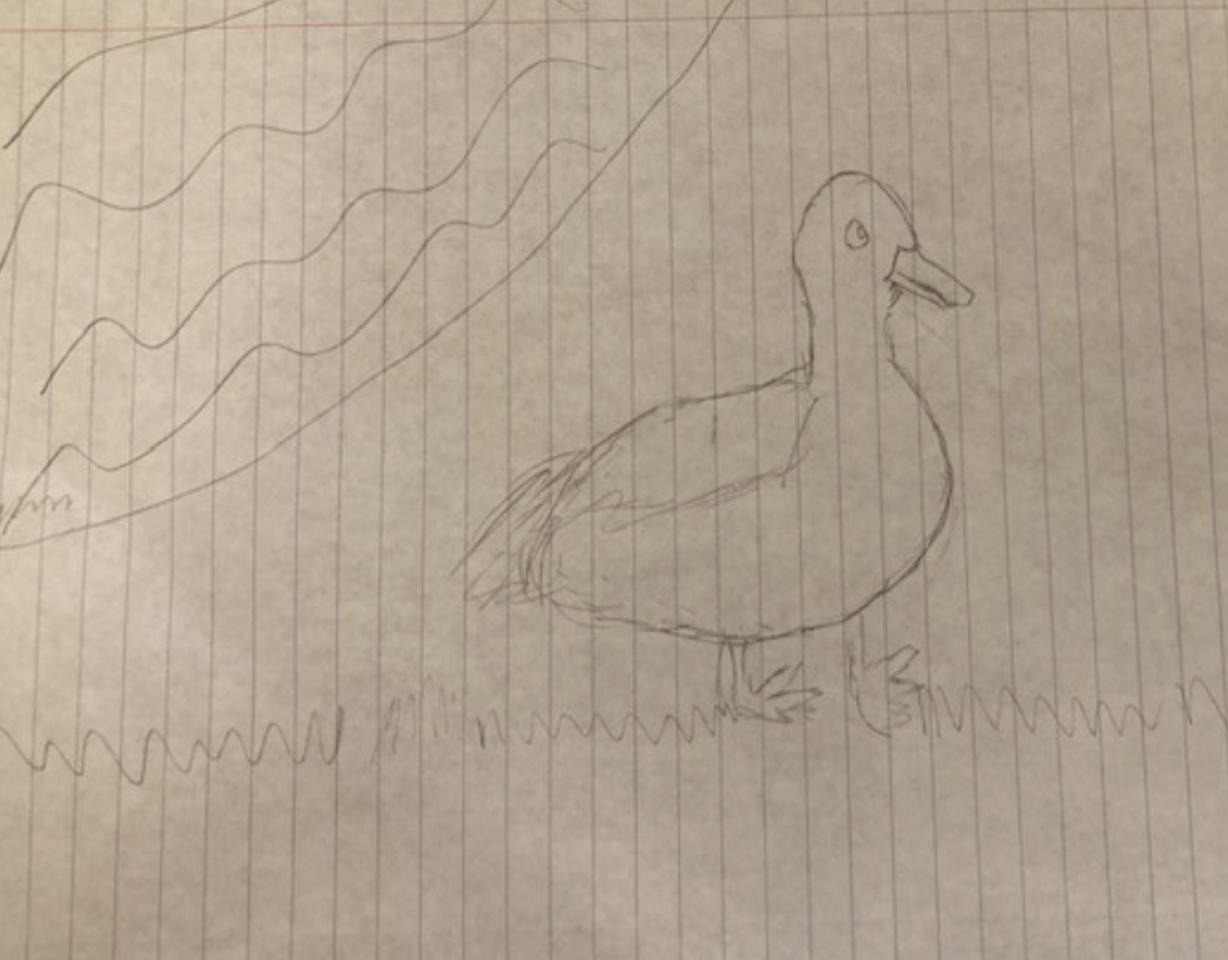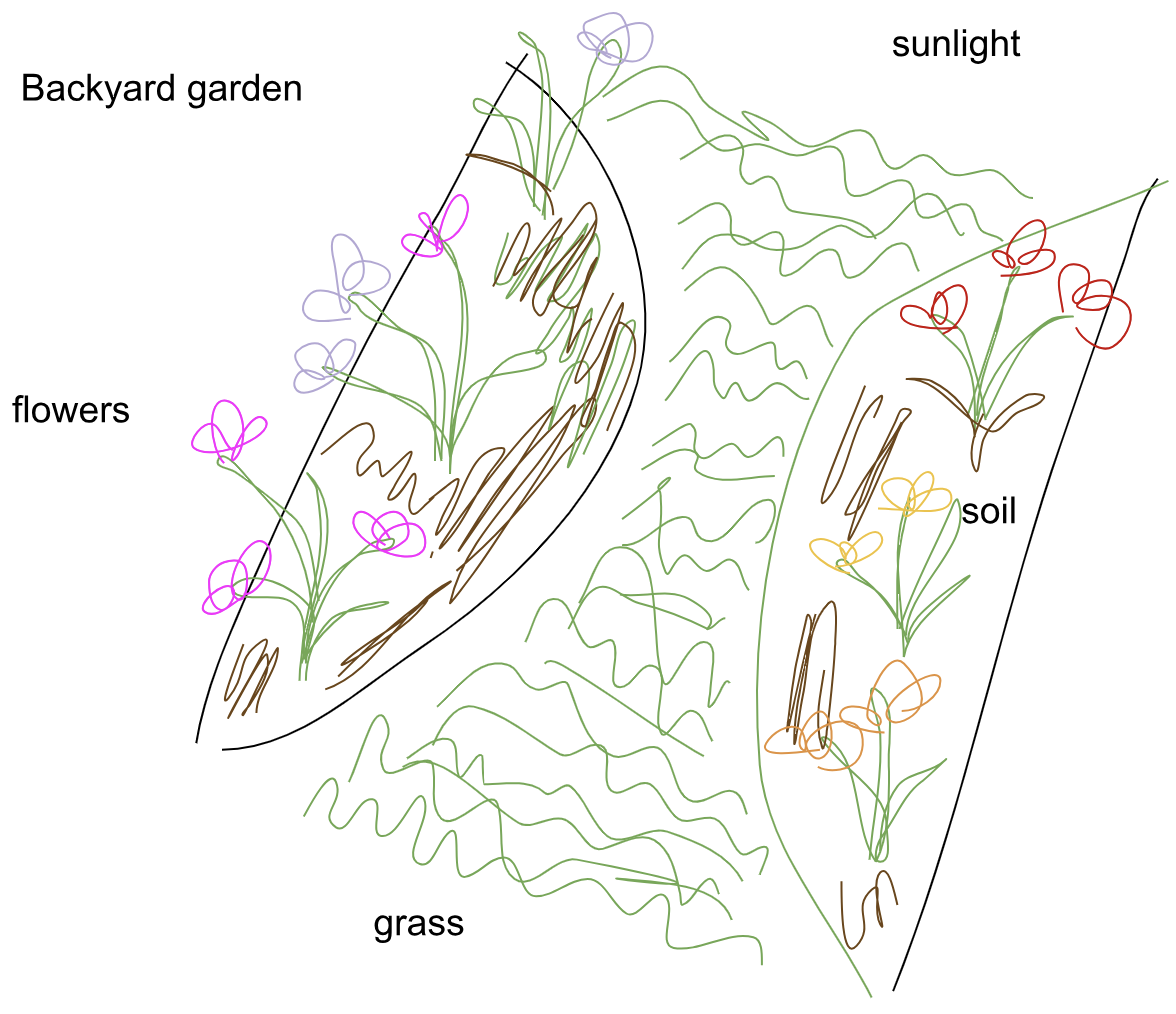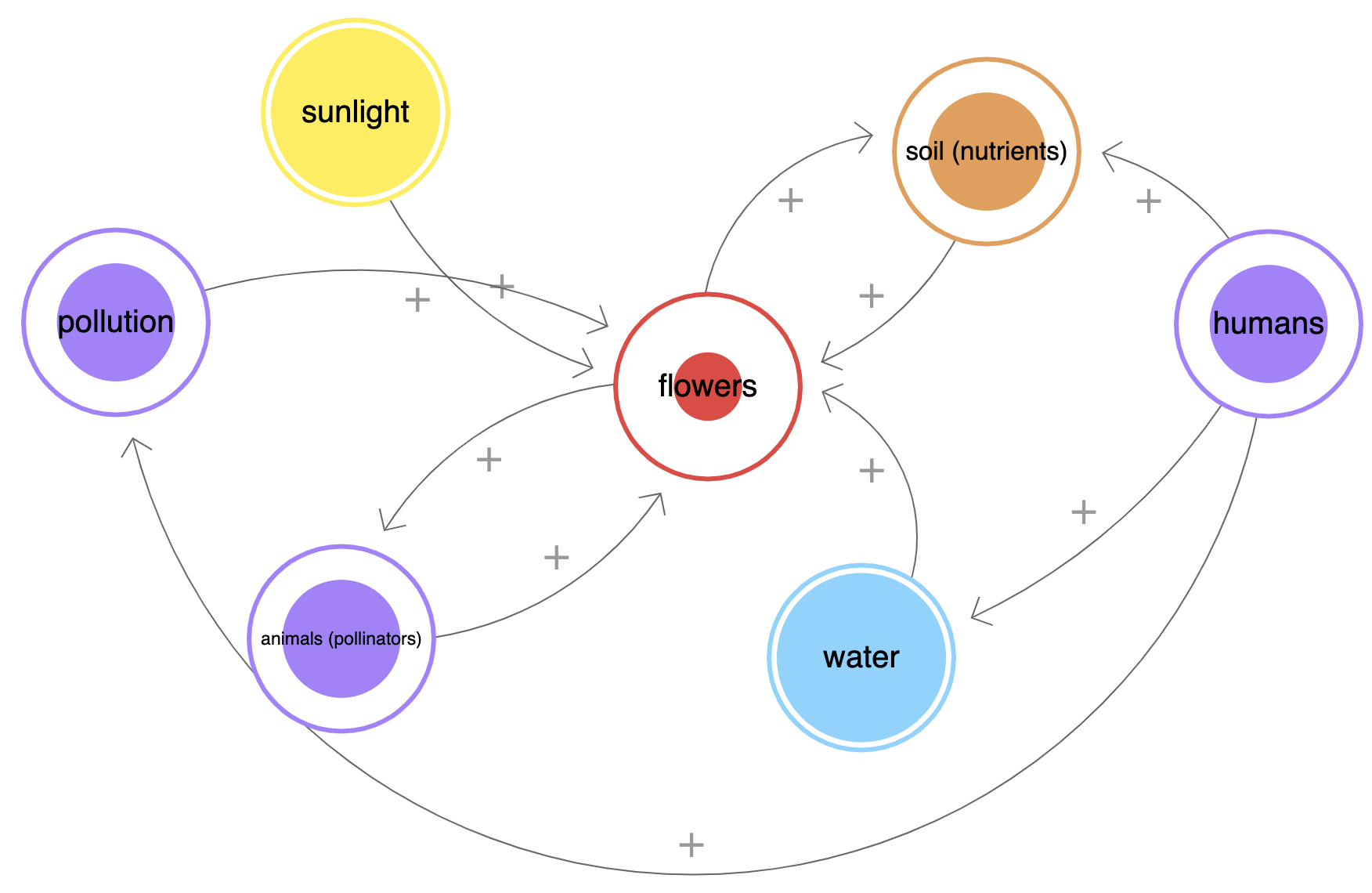Environmental Systems are Everywhere
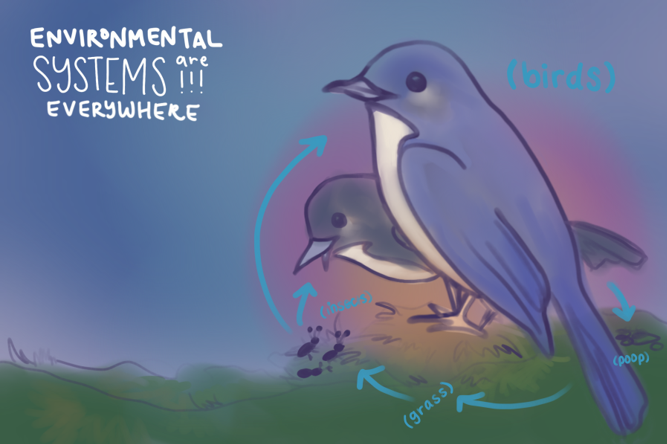
Scroll through the page or use the direct links below to view examples of student work from the Environmental Systems are Everywhere asynchronous activity that was completed as part of SEE's Environmental Systems in the Outdoors Research Experience (ESORE). Images of Loopy models created by students are linked so that you can explore the interactive model on the Loopy website. At the bottom of the page, there is a link for educators to access resources to try this activity with their students!
Mohuwa Wahid, Kamiak High School
One core environmental problem that affects the system is the introduction of a non-native and invasive population of rabbits. Since rabbits quickly reproduce, its introduction has quickly overwhelmed the resources available in both the system, my front yard, as well as the greater ecosystem. There is no definitive answer as to where these rabbits came from, but it can be hypothesized that they were previously pets and then released into the wild.
| Systems Thinking Skill | How could it be used? |
| Predict Future System Behaviors | Predict how the introduction of rabbits can be detrimental to other wildlife and plant species |
| Respond to Changes Over Time | Take steps to counteract the impact of the invasive population using predictions of how solutions will change over time |
| Differentiate and Quantify Elements | Analyze the growth and population increase rate of the rabbits |
| Characterize Feedback Loops | Determine the positive and negative impact of the invasive species |
Anushka Kapalli, Newport High School
Pollution, I would say the source is from vehicles, heating and cooling systems in houses, emissions from factories, etc. Additionally, too much sunlight and pollinator decline are also problems.
| Systems Thinking Skill | How could it be used? |
| Identify relationships | This skill could be used to identify the relationships between the environmental issues and what factors are causing them. |
| Consider issues appropriately | This skill could effectively allow for the consideration of what the best approach is to these issues. |
| Respond to changes over time | This skill could allow for the knowledge and thoughtful effort of approaches previously to be put into use and help with the issues. |
Helen Shen, Inglemoor High School
Pollinator decline due to habitat loss, deforestation, climate changes
Hummingbirds: pesticide use, improper use of chemicals, habitat loss, predatory pets (especially cats), climate change causing poor weather, introduction of nonnative/invasive plant species
Bees: colony collapse disorder due to high levels of insecticides, parasites, and radiation in the air
Butterflies: deforestation (causes loss of habitat, increased predation, migration changes), temperature changes, rainfall fluctuations, impacts on migration patterns
Ants: (observed on the branches of the peach tree in question) pesticides and chemicals, but otherwise, are difficult to affect on a large scale
| Systems Thinking Skill | How could it be used? |
| Explore Multiple Perspectives | Using different points of view from different points in the system, we can uncover faults, problems, and roots of the issue. Accounting for multiple perspectives allows for a bigger picture and more varied research. For example, we could look at the system from each pollinator’s point of view, and see how the absence of each one could impact the sustainability of the system. |
| Differentiate and Quantify Elements | The abundance of each part of the system can be quantified to understand each contributor’s impact upon specific parts of the system. For example, the peach tree is what the entire system revolves around, but the abundance of wildlife, pollinators, and nutrients are in far greater numbers. |
| Describe Past System Behavior | Past system behavior could be defined as a period of time in which all parts of the system functioned normally. Or, it could just be current observations of the system’s functioning. For example, we could observe the fluctuations in the system over the seasons, and come up with averages for each period of time. |
| Predict Future System Behavior | Predicting future system behavior is heavily based on past system behavior, as we must use past observations to be able to predict the future behavior of a system. However, if a system is damaged, it may be difficult to predict how the system will behave. For example, if a complication unlike any circumstance the system has encountered beforehand/on a regular basis arose, unpredictability increases. |
| Identify Feedback Loops | Identifying feedback loops may be advantageous in specifying positive and negative feedback loops throughout the system, and further analyzing how these loops impact each other. For example, insects may devour the leaves of the peach tree, inhibiting the development of the tree/production of fruit/process of photosynthesis, but their presence may promote pollination if they come in contact with the flowering parts of the tree. |
Claire Y.
Water pollution - potential chemicals getting washed into the pond from runoff
Air pollution - vehicles, fracking, agriculture, homes
Pollinator decline - use of pesticides, herbicides, insecticides, habitat destruction and fragmentation
Overall biodiversity loss and decreased resistance - a result of all the factors listed above
| Systems Thinking Skill | How could it be used? |
| Differentiate & quantify elements | Be able to break down each part of the pond system and understand how it works |
| Characterize relationships | Determine how different parts of the pond system are interconnected |
| Characterize feedback loops | Determine the impact of one element of the pond system on another |
| Describe past system behavior | Understand how the pond ecosystem has adapted to change in the past to help predict the future |
| Predict future system behavior | Create hypotheses about how the pond ecosystem will be impacted by different issues using prior knowledge gathered |
Amara Maw
A core environmental problem that affects the hills in my town is the current drought throughout California. The drought can be attributed to a number of factors, such as rising temperatures, a lack of humidity, and a lack of precipitation. The dryness causes the hills to be covered with dry grass prone to catching fire.
| Systems Thinking Skill | How could it be used? |
| Consider the Wholes and Parts | When forming a solution to address the drought that results in the dry, yellow hills, the wildlife that calls the hills home would have to be considered. It would be important to make sure that the animals and plants that inhabit the area are not affected negatively. |
| Identify Relationships | Recognizing how factors such as high temperatures and excessive water usage contribute to the drought could help address the issue. Developing a solution addressing the drought, in turn, can help bring life back to the hills and further develop the local ecosystem. |
| Describe Past System Behavior | When forming a solution to address the drought, it would be useful to reflect upon past droughts and the successes and failures of how they were addressed. |
| Consider Issues Appropriately | In addressing a drought, it would sound most logical to limit the water usage of residents. However, this is not always realistic, as water is essential to many functions. Additionally, high temperatures not only contribute to the drought but also naturally result in an increase in water usage. So a more sustainable solution would have to be formed. For example, we could try combating the rising temperatures by encouraging energy-efficient activities that reduce the burning of fossil fuels. This would address one of the factors contributing to the drought, and is more sustainable than just controlling the water usage of residents. |
Amanda Zheng
Unstable urban growth affects this system by decreasing the amount of space for rabbits/predators/grass to grow. This problem comes from increased population growth and bad urban planning.
| Systems Thinking Skill | How could it be used? |
| Consider the Whole and Parts | This skill allows for people to properly plan out urban sprawl so it doesn’t become unsustainable. |
| Predict Future System Behavior | Helps us account for changes in the future that could |
| Identify Relationships | Make sure we don’t miss how urban growth affects all the nearby flora and fauna. |
| Consider Issues Appropriately | It’s a big issue that involves many groups, so careful consideration is important. |
Nikolette Warycha
The biggest issue an Avocado farm faces is the current drought and high temperatures in California. With the lack of rainfall and temperatures reaching over 90 degrees daily, the trees struggle to grow with less water being used. However, the water used on farms themselves are a massive contributor to the drought we are in currently.
| Systems Thinking Skill | How could it be used? |
| Explore multiple perspectives | To look at how a solution could be reached so the drought would have less effect on the farm and how the farm could have less effect on the drought. |
| Differentiate and quantify elements | Assessing the stocks and flows of the farm including drought would help look at the water being used in the farm. |
| Feedback Loops | To understand the complex feedback of how the farm can contribute to drought while the drought contributes to less avocados. |
| Respond to changes over time | If we can reduce water usage in a farm and see if the avocados are still producing at a steady rate, then possibly it would have less effect on our drought. |
Monica Ballas, Redmond High School
Anjana
Inorganic chemical pesticides will protect the grass in the system, but can harm the insects’ internal systems, and later birds through bioaccumulation.
| Systems Thinking Skill | How could it be used? |
|
Consider the Wholes & PartsAlways keep in mind both the whole of a system and its parts (like thinking about a whole forest as well as all the trees within it at the same time). |
It’s necessary to consider the wholes and parts in this system because of how many parts there are to it. For example, within the category of “insects” as modeled in the diagram are various different insects that may be affected in a slightly different way by the same pesticides. |
|
Describe Past SystemBehavior Understand how a system’s whole and its parts have worked in the past. |
Understanding how the system worked in the past (before introduction of the pesticide) is necessary to restore the system to peak condition. |
|
Characterize RelationshipsUnderstand the strength and manner in which system elements are related |
Understanding the way parts are interconnected is integral because of how one small change may drastically change the whole system. For example, the introduction of more pesticides may have a much stronger impact on the “insect” group than expected. |
|
Respond to Changes OverTime Avoid falling into a comfort zone with the way you approach a system, because it may change over time. Instead, continually evaluate and improve the strategies you use with it. |
New pesticides are rapidly being developed, and this may affect the system as different pesticides are introduced and used. The same strategy used to counteract one pesticide may not work the same as a different strategy, and therefore we will need to constantly assess and improve the strategies used. |
Elizabeth Leung, Redmond High School
Core environmental problem: invasive insects which can eat away at plants in the garden. The source of the problem is generally from insects and other pests boarding shipments to Mauritius, populating the island and spreading vastly.
| Systems Thinking Skill | How could it be used? |
| 2: Consider the wholes and parts | Certain invasive species have been on the island from a very long time. It is important to understand how the system will function without these invasive species. Not necessarily just for the personal garden, but also for farms and sugarcane plantations. |
| 5: Consider issues appropriately | It might not be possible to remove invasive species at this point. Even trying to do so will be extremely hard. It needs to be thought on how much time, effort, and money should be afforded to spend on the issue. |
| 14: Predict system behavior | How will plants/farms/gardens function with the growing population of invasive species in the future? Will the farms truly improve (with a “good enough” level) with the removal or cut down of invasive species? |
A core environmental problem that affects my system is water pollution. Water pollution has been lowering the reproductive success of ducks and has been harming the survival of young ducks. The source of the above environmental problem comes from human beings leaving behind trash, especially plastic, when they visit parks/the habitats of the ducks.
| Systems Thinking Skill | How could it be used? |
| Identify Relationships | I could use this skill to address the environmental problem because understanding the positive impact that ducks have on their surrounding environment can help a larger audience to realize that water pollution does not only affect the ducks but the whole environment around us. |
| Predict Future System Behavior | I could use this skill to address the environmental problem because there have been past examples of other environmental systems being harmed due to the extinction/reduction of their core organisms. (Elephants?) |
| Maintain Boundaries | We may need to continue to update the model/system, especially with the negative impacts that the ducks have on the environment such as their feces contaminating the environment. However, by looking at the negatives and by continuing to update the system, we may come to see that ducks have a greater positive impact on the environment. Therefore, we need to address the above environmental issue to help the ducks. |
Sarah R., Kamiak High School
One environmental problem is the rise of invasive plant species like weeds that quickly reproduce. The presence of these species overwhelms the system by taking up nutrients from the soil and water that can interfere with the growth of the flower species. If this continues, the flowers can be malnourished and even begin to die.
| Systems Thinking Skill | How could it be used? |
| Consider the wholes and parts | By identifying the different parts of the system in my background and considering how they work together, we can hypothesize how changes in one part of the system can ripple through and affect the system as a whole. |
| Predict future systems behavior | By considering the parts of a system, we can predict future growth. |
| Maintain boundaries | Each part of the system has its place and role, and it is important to maintain boundaries. For example, while pollinators are an important part of the system, too many can overwhelm the system. Similarly, water is necessary for a plant to flourish, but too much can be detrimental. |
Delphine Lach, Lincoln High School
FOR EDUCATORS
Interested in learning more about this activity and trying it out with your students? Check out resources for this activity HERE.


